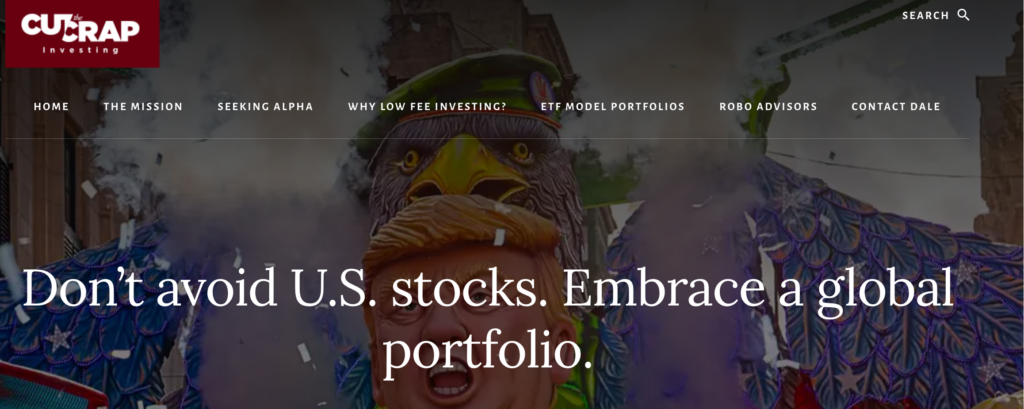By Dale Roberts
Special to Financial Independence Hub
We all know that Canadians are up in arms (well, elbows are up to be more specific) over President Trump’s strategy to destroy Canada, economically. There is a national wave of pride that says ‘Buy Canadian’ and avoid most anything produced in the U.S. More Canadians refuse to cross the border as well, tourism to the U.S. is down significantly. And while U.S. produce rots on the shelves at No Frills, many Canadian investors are also dumping their U.S. stocks in protest. This is the financial equivalent to cutting of your nose to spite your face. Don’t avoid U.S. stocks. Embrace a global portfolio.
Now I certainly understand, here’s the kind of motivation that gets our elbows up …
Of course Canadians will take a pass on that 51st State offer. But we should not take a pass on U.S. stocks. While you may not be a fan of the United States of America, it is still where they keep most of the best companies on earth. It is where they keep the best stock market on the planet. It’s where the entrepreneurial spirit and innovation rages like no place on earth.

Good luck hanging out in Rogers
Ironcially, the best way to protect against economic attack might be embracing our attacker. At least in a portfolio sense. What if they win? What if they destroy Canada economically? They can. Trump might. The U.S. would get stronger as we get weaker. Good luck hanging out in Rogers, Bell, BMO, CIBC, Enbridge, Magna and Suncor. Remember, America doesn’t need anything that Canada produces 😉
A portfolio can be used to hedge most economic events in life, even our country’s economic demise. I suggest that you protect yourself and your family first. Don’t remove what might be your best line of defence. If the U.S. remained an economic powerhouse (with U.S. companies leading the way), and the Canadian stock market and Canadian dollar collapsed, owning these great U.S. companies would make you rich in your own land. And in grotesque fashion, the greater the divide the richer you would get in your own land by way of those U.S. holdings. Here’s the U.S. market going up 4-fold from 2013 with the added currency boost. The weaker the Canadian Dollar, the greater your return.

Warren Buffett does not hate you
Keep in mind that the C.E.O.’s and management at Berkshire Hathaway, Pepsi, Microsoft, Home Depot, Johnson & Johnson and Apple are not out to get you. Quite the opposite, they know a massive tariff war is a very, very, very bad idea for everyone.
In fact, Warren Buffett slams Donald Trump’s tariffs on Canada and Mexico and calls them an act of war. Most business leaders don’t like what’s going on, and it’s the same for so many, or most Americans …
And in Vermont …
The fact that a tariff war is a bad idea might be reason for optimism. For Seeking Alpha this week I offered Defensive stocks for unpredictable Trump policy.

From that article.
My take on the global tariff war concept is …
The bad news is a global tariff war spells economic destruction.
The good news is a global tariff war spells economic destruction.
Essentially, it can’t happen, I think and hope. The markets will push back and so will voters if the economy continues to weaken, and we see a spike in inflation.
It’s safe to say that Trump does not want to be a half-term President, again. They have mid-term elections in 2026.
But U.S. stocks are underperforming
Yes, you might have noticed. And I’ve been pointing this out to readers for several weeks. The markets have been turning their back on U.S. stocks and are embracing international equities.

The reasons are likely two-fold. The U.S. market is terribly expensive, and market makers are certainly nervous about the global economic and political rewiring that is taking shape. Europeans, Canadians and many others are looking to stick together in case this global tariff attack becomes a ‘real thing’ beyond rhetoric and threats.
When you put together a global ETF portfolio, you might choose to equal weight U.S., International and Canadian equities. I also like the idea of gold in the balanced portfolio as I’ve put forth from the beginning of this blog. I’m a big fan of layering in a value tilt for U.S. stocks as well.
As a semi-retiree I also like U.S. defensive stocks as you’ll see in this Sunday Reads from a few weeks ago.
The stock market is not the economy.
That goes for Canada and the TSX. That goes for America and the S&P 500 and the Nasdaq 100. That goes for the stock markets in Europe and Asia.
I would not avoid Canadian stocks, either. We’re just going to manage the risk with a global portfolio. Canadian stocks have been performing quite well, even with Canada in a per-capita recession for quite some time. The TSX 60 companies generate almost half of their revenues outside of Canada. Even though Canadian business sentiment is deteriorating …
Of course, you can own a diversifed global portfolio by way of the Canadian asset allocation ETFs. Here’s XBAL-T over the last year: the fund is up almost 2% in 2025 as well …

Ahhh, the global balanced portfolio 🙂 Currently the ETF is 26% U.S. equities, 15% Canadian, 15.5% International developed and 3% developing markets. 40% of the fund is in Canadian and U.S. bonds.
XGRO-T is up 11.5% over the last year.
Ignore the noise
I know it’s not easy, but do your best to not react to the ‘noise’ and threats. I think it’s a great idea to buy Canadian and avoid the U.S. products and travel. That will put pressure on U.S. companies and services. But prioritize your economic safety over retaliation. Stay the course with a global portfolio. Manage the risk as you need with cash/bonds/gold/defensive equities.
Be sure to invest within your risk tolerance level. Be sure to understand all tax consequences if you make any portfolio moves in taxable accounts. I just added ‘how to invest in taxable accounts’ for Retirement Club. That should generate some good discussion in our secure online community, as one of the club members has asked the group for ideas on how to invest a $700,000 inheritance.

 Dale Roberts is the owner operator of the Cut The Crap Investing blog, and a columnist for Seeking Alpha This blog originally appeared on Cut the Crap Investing on March 23, 2025 and is republished on Findependence Hub with permission.
Dale Roberts is the owner operator of the Cut The Crap Investing blog, and a columnist for Seeking Alpha This blog originally appeared on Cut the Crap Investing on March 23, 2025 and is republished on Findependence Hub with permission.


